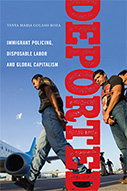Deported: Immigrant Policing, Disposable Labor, and Global Capitalism

Author: Tanya Maria Golash-Boza
Publisher: New York: New York University Press, 2015. 320p.
Reviewer: Vincent Ferraro | September 2016
When Barack Obama leaves office in January 2017, he will do so having deported more people from the U.S. than any other president. And yet, in the current political climate, would-be candidates continue to gain significant traction by promising to address the “immigration problem,” and by stoking public anger and fear with an old call to build a wall along the Mexican (but not Canadian) border. Why is it that, over the last decade, with little public attention and scant media coverage, the U.S. has quietly ramped up its deportation efforts, processing nearly three million people out of the country? Are deportations really making us safer? Who are the people being deported and what happens to them when they leave? It is to these questions and more that Tanya Maria Golash-Boza seeks to provide answers in her recent book, Deported: Immigrant Policing, Disposable Labor, and Global Capitalism.
Deported is a welcome addition to studies of immigration, social control, global capitalism, and especially the growing body of work on deportation. Drawing upon in-depth interviews, Golash-Boza provides an important cross-national perspective, highlighting the ways in which the motivations for entry, process of incorporation, reasons and methods of removal, and consequences of deportation on life after return to one’s home country, differ by country of origin, itself a proxy for political relations, immigrant history, and economic conditions. She does so from a critical perspective that locates the U.S. policy of deportation within a larger global framework, arguing that the emergent form of “mass deportation” is a function of global capitalism’s need to maintain a pliable global workforce. A major contribution of the work is to link the findings on deportation to research on mass incarceration, convincingly showing the ways each operates as social control for those deemed troublesome or unnecessary, whether born inside the U.S., in the case of mass incarceration, or born outside, in the case of mass deportation.
Golash-Boza’s methodology involves interviews with a sample of 147 deportees drawn from four sending countries: Jamaica (n=37), the Dominican Republic (n=46), Guatemala (n=34), and Brazil (n=30). This cross-national view uncovers some striking similarities in the deportation experience as well as important differences. Further, the framework allows Golash-Boza to provide a detailed treatment of the process of deportation in a global perspective, noting for example, how economic outlook in the home country, political relations with the U.S., and transnational corporations impact the decision to leave, the location of settlement in the U.S., and ultimately the degree of stigma upon return to one’s country of origin. This choice of method is important for shedding light on the experience of deportation, and while Golash-Boza devotes a brief section to her methods (p. 21-22), a more detailed discussion, perhaps in an appendix, of how subjects were selected for inclusion and how responses were coded for analysis would have been a welcome addition to the text. The book offers several “interludes” which provide extended accounts from the study’s subjects. Those stories and others offered throughout the text are powerful, touching, and instructive to students and scholars of immigration, political leaders, activists, and lay persons alike, and I was left wanting to read more from the subjects themselves.
Deported begins by introducing the concept of the “neoliberal cycle,” which Golash-Boza argues is a necessary cause and feature of global apartheid. While globalization requires the free movement of capital across national borders, the free movement of labor is problematic. Consequently, the rise in deportations at this moment in history, is very much in keeping with neoliberal reforms; it produces a vulnerable work force in the deporting country (due to fear) and in the home country to which deportees are returned (due to stigma—though as the author shows, the degree to which deportation serves as a stigma in the home country varies considerably). The book provides a short discussion of neoliberalism from a critical perspective, though for some a primer may be necessary.
The book proceeds sequentially, mirroring the process from the decision to leave, through the migration experience, to settlement, deportation, and ultimately return to one’s home country. It is a useful convention that allows the reader to gain a sense of the tumultuous nature of the process, particularly for those who are deported shortly after their arrival in the U.S.
“Growing Up” (Chapter 1) offers an overview of life prior to deportation; like the chapters to follow, it is organized by country of origin. In it, the similarities across the regions of origin in subjects’ motivations for migrating (e.g. lack of economic opportunity at home and a desire to make a better life for one’s self and family) are clear, as are important differences, which center heavily on economic opportunity at home. For example, Golash-Boza finds that while Dominicans and especially Jamaicans saw their immigration to the U.S. largely as permanent, Brazilians, and to a lesser degree Guatemalans, saw it a temporary means to obtain wealth, before returning home. For Brazilian deportees, the excursion to the U.S. is a way to build up capital that would allow them to more quickly stake their claim in Brazil’s booming economy.
“Crossing Over” (Chapter 2) details the migration process itself, which varies greatly depending on country of origin and when and how migrants arrived. Significant enhancement to U.S. border security over the last two decades, coupled with dangers associated with increased narco-trafficking, have made the journey more dangerous for those who enter illegally, particularly for Guatemalans and Brazilians whose primary pathway for illegal entry is through Mexico. These changes have not eliminated illegal entry but have made it more perilous. Routes have become more dangerous in order to avoid detection. Costs have increased, ensuring migrants accrue a sizeable debt and, consequently, are more likely to “serve as a vulnerable workforce” (p. 90) once in the U.S. The chapter documents well the high costs associated with the journeys, at once underscoring the commitment of the subjects to a better future and the precariousness of their situation.
“Becoming (Black and Latino) American” and “The War on Drugs” (Chapters 3 and 4) draw heavily from the segmented assimilation perspective, arguing that the place of settlement and context of reception impact heavily upon the chances for economic success and social integration. Dominicans and Jamaicans in particular are funneled into high-crime and heavily policed areas, which adds an important piece to the literature on segmented assimilation — the settlement by some into areas of intense enforcement and racialized poverty makes it more likely that certain groups will become exposed to the underground economy, the system of mass incarceration, and ultimately the deportation apparatus. This extension of the context of reception and the location of settlement to include hyper-policing may be one of Golash-Boza’s strongest contributions, as she draws clear links between assimilation and mass incarceration research. Notably, Golash-Boza suggests that many of the subjects who sold drugs did so only during their time in the U.S., not in their home countries, suggesting that entry into dealing is a feature of the American experience, owing to the availability of drug markets, established social networks, and consumerism.
The issue of subjects’ criminality is, however, a difficult one. Golash-Boza notes that she did not independently verify respondents’ reports, especially with reference to the events leading up to their deportation. This may well be due to the difficulty in obtaining such verification or perhaps it was a means of protecting the identities of her subjects and their families. While this reviewer is inclined to accept the author’s argument that in some ways the perceptions of the events, and the meanings attached to them, matter just as much as the legal facts, other readers may find it problematic to the degree that reports appear self-serving on the part of subjects. Here again, a more detailed discussion of the method of subject selection and data analysis may have been helpful.
“Getting Caught” (Chapter 5) explains the process of being captured by the immigration control system. Far from hardened criminals, many of those interviewed (just as many of those deported more broadly) were apprehended for non-violent offenses such as minor traffic accidents and minor drug possession. The concept of “disproportionate deportation” highlights the clear racial component to the enforcement arm of immigration — men, immigrants of color, and especially those from the Americas are most likely to be deported under U.S. policy. Golash-Boza does well to explain the ways in which the social control aspect of deportation extends far beyond those deported and even their families, in order to serve as a message to others in the community.
“Behind Bars” (Chapter 6) takes us into the experience of incarceration. The chapter offers a useful analysis for those interested in law, corrections, and the legal gray zone surrounding deportations. Many of the subjects spent time in U.S. jails prior to deportation and nearly all spent time in an immigration detention facility, where they were held until their ultimate removal. While in such facilities, subjects are not technically incarcerated, yet a surprising number described the experience of detention facilities as being worse than prison, as they reported being denied the basic rights of the incarcerated. The message is clear: the harshness of treatment functions to encourage deportees to accept deportation as quickly as possible and to avoid protracted legal battles, even if they have legitimate grounds on which to appeal their deportation orders.
Nowhere is the cross-national variation in experience clearer than in the chapter on the experiences of deportees after their return home (“Back Home,” Chapter 7). In some countries, deportation has few lasting consequences (Brazil and Guatemala), unless the deportee has picked up tattoos along the way (Guatemala). In others, being a deportee marks the individual as a second-class citizen (Jamaica and the Dominican Republic). If economic difficulties were severe prior to immigration, they are much worse after deportation. That many of the subjects, however, seem resigned to accept their more marginalized conditions after deportation, suggests its effectiveness at producing a passive workforce. Among these returnees, Golash-Boza finds also a “gendered shame” (p. 226), as many of the male subjects, whose immigration to the U.S. was motivated by a desire to make a better life for their families, found themselves on return dependent upon remittances from wives, girlfriends, and mothers for their financial survival.
One of the most striking findings comes from the subjects from Guatemala and the Dominican Republic, where deportees, with their English-language abilities and familiarity with American culture(s), are welcomed by transnational companies as ideal workers for the corporations’ call centers. As Golash-Boza notes, the irony is thick — Americans oppose and deport immigrants in part on grounds that they threaten Americans’ jobs; and yet upon their deportation, they become ideal candidates for the very American jobs that global businesses have outsourced, and precisely because of their Americanism.
The book’s concluding chapter provides a nice review of the main findings, and makes its major contribution in showing how the process of deportation, which disproportionately affects immigrants of color, is buttressed by a system of neoliberal color-blind racism.
Tanya Maria Golash-Boza’s Deported is a much needed contribution, covering the ways in which contemporary U.S. deportation policy functions neither to end immigration nor to remove all deportable persons. Instead, as Golash-Boza convincingly shows, its function is to reproduce systems of inequality on a global scale, most notably via a vulnerable workforce in the U.S. and abroad. One that is both servile to the demands of global capitalism and predominantly non-white. In linking research on immigrant settlement and segmented assimilation with research on mass incarceration, the drug war, and colorblind racism, the text draws much needed connections that help to put the dual processes of mass incarceration and mass deportation into a global perspective.
Vincent Ferraro, Ph.D., Assistant Professor, Department of Sociology, Framingham State University


